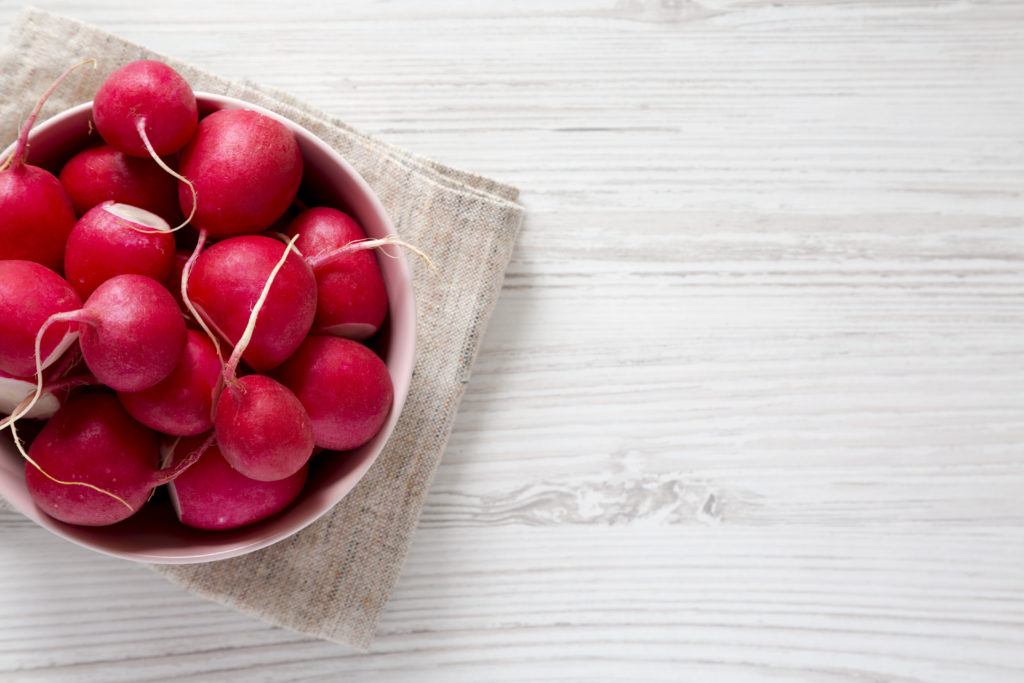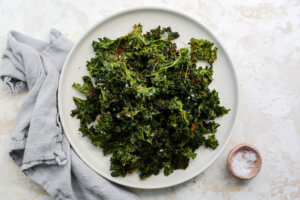Poor little radishes. They’ve been relegated to duty as a garnish, or, if they’re lucky, a spicy addition to a salad. But beyond that, many spend their creative juices focused on other produce. Not cool. It’s time for some radish education! Radishes are packed with flavor, nutrition and look beautiful on the plate. Pick up a bunch on your next shopping trip. You’ll be surprised by their incredible taste.
What do they look like?
Radishes are a cruciferous vegetable that typically have a small, round, crimson red bulb topped with slightly-fuzzy, edible greens on top. They’re also root vegetables, as they grow underground. If you’re browsing the farmer’s market, you’ll probably see a wide variety of colors and shapes beyond the standard red globe. Tip: Look for hot pink, white, yellow, purple, and dark red heirloom varieties that come in all shapes and sizes.
There are a few different types of radishes. The one you’re likely thinking of is the one we described and used for the photo above: raphanus sativas. But radishes don’t have to be red: there’s actually a black radish and a white radish! White radishes are known as Daikon radishes and are popular in Asian cuisine.
What do they taste like?
When eaten raw, radishes are spicy, crisp, and zesty. Varieties can range from very spicy (similar to the heat of raw garlic) to very mild – for example, Daikon radishes are milder than red radishes. Cooking brings out the sweetness and milds the spice.
Radish leaves, or greens, are also edible, and have a flavor similar to mild spinach. However, the fuzzy texture of raw radish leaves can be a bit off-putting to some folks, so it’s recommended that you eat them cooked. They’re also a great alternative to basil if you’re making pesto and want to reduce your food waste!
Why are they good for me?
Radishes have health benefits that go far beyond their nutrition info, and nutrition stays similar for different types of radishes, like Daikon. This root vegetable contains the antifungal protein RsAFP2, which has been found to cause cell death in Candida albicans. Candida albicans is the fungus responsible for yeast infections, so you definitely don’t want it to build up! Radishes are also a natural diuretic, which means they keep your kidneys and urinary tract clean and healthy. And like most cruciferous vegetables, they’ve got high water content and dietary fiber (two grams of fiber per cup) to keep your digestive system healthy. They also boast a low glycemic index, as one cup of radishes contains just four grams of carbs. The glycemic index (GI) is a relative ranking of how carbohydrates affect blood sugar levels. A low GI means you can add radishes to your daily diet without affecting your blood sugar. And why wouldn’t you want to?
Not only do radishes have great benefits for your gut, they’re also packed with nutrients that help your immune system. They’re a good source of vitamin C (one cup covers almost 20 percent of your daily value!), vitamin B6 and potassium. Potassium is an important mineral for your blood pressure. It helps ease tension in blood vessel walls, which means it’s easier for your red blood cells to travel through those vessels, effectively lowering your blood pressure. And of course, being a vegetable, they contain virtually no fat or saturated fat.
In addition to all this great radish nutrition, it’s been shown that radishes can help combat oxidative stress. If you aren’t familiar with oxidative stress, here’s some helpful information. Oxidative stress happens when there’s an imbalance between the production of damaging free radicals in your body, and your body’s ability to counteract their harmful effects with antioxidants. By combating oxidative stress, radishes can help protect your body and keep you healthy.
When and where do I get it?
Standard red globe radishes are available nearly year-round in most major supermarkets. But for the best flavor, color, and crunch, check out your local farmer’s market during late Spring or early Summer, and then again in the Fall.
Radishes are also one of the easiest and quickest producing veggies you can grow in your own garden. Plant a few radish seeds in early spring and within 4-6 weeks (with almost no maintenance) you’ll have fresh radishes to snack on.
How do I prepare radishes?
Most people eat radishes raw by washing them well and then slicing off the greens. You can eat them whole (dip those babies in hummus) or slice them thinly to add a spicy crunch to salads. You can also roast radishes to get a sweet, delicious side dish that has a flavor and texture similar to cooked zucchini. The radish skin gets nice and crispy, so make sure to leave it on. To roast, simply arrange radishes on a baking sheet in a single layer. Add a drizzle of olive oil (you can use more or less, depending on how much fat you want to add to the recipe), and a sprinkle of salt and pepper, then mix on the sheet pan until the radishes are coated with oil. Once mixed and thoroughly coated with fat, spread radishes back into a single layer, then place the baking sheet in the oven at 400 degrees for 30 – 40 minutes.
Radishes are also a great choice for people on the keto diet. Keto dieters like to substitute radishes as a low-carb alternative for potatoes in recipes like loaded baked potatoes, because they provide total fat and flavor (from ingredients like bacon and parmesan cheese) with fewer calories from carbohydrates. This popular keto radish recipe uses bacon, bacon grease, parmesan cheese, heavy cream and fresh rosemary to create delicious pan-roasted radishes in cream sauce. But remember, just because this recipe is low-carb, doesn’t mean it’s super healthy. If you’re not following the keto diet for your regular meal plan, those calories from fat can add up quickly!
If you want to absorb all that great radish nutrition without cooking them, you can also make radish juice. Radish juice is as simple as it sounds – simply add radishes to your juicer and enjoy! You can leave the skin on while you juice, and we’d recommend adding a few other veggies for flavor, like in this recipe.
These above recipes are all great for red and pink varieties of radishes, but they won’t be quite as delicious made with Daikon radishes. Daikon radishes don’t just have a different name – they also have a different flavor profile that makes them well-suited for Asian cuisine. They have similar nutrition information to red radishes, so if you want to add them to your meal plan, you could make this Daikon radish salad, stir fry with Daikon radishes, or just pickle them to add extra flavor and crunch, without adding calories.
If you want to avoid food waste, you can also cook radish greens. To cook radish greens, saute one cup of them in a bit of butter or oil until tender and wilted. Bacon is a great way to add flavor to radish greens, but note that it will add saturated fat pretty quickly! Or, they work really well in soups and stews. You see radish greens used frequently in a creamy bisque (see below for a recipe suggestion).
What are some tasty recipes?
After you’ve gotten your fill of eating radishes raw, try out some of these adventurous radish recipes:



